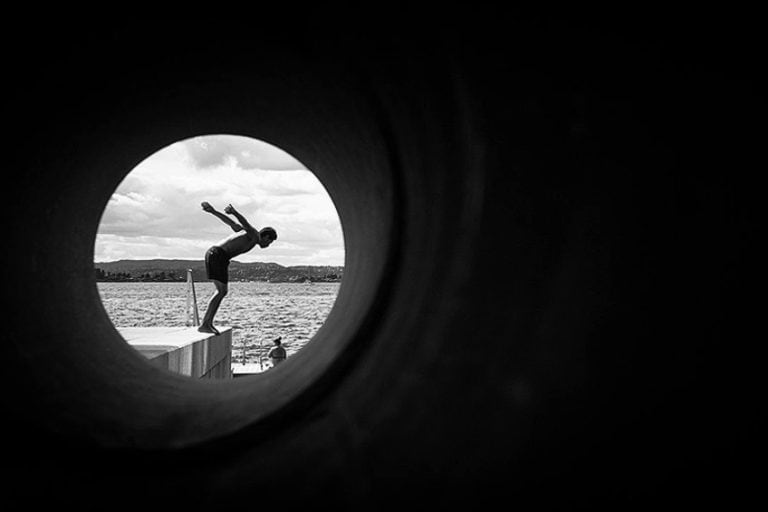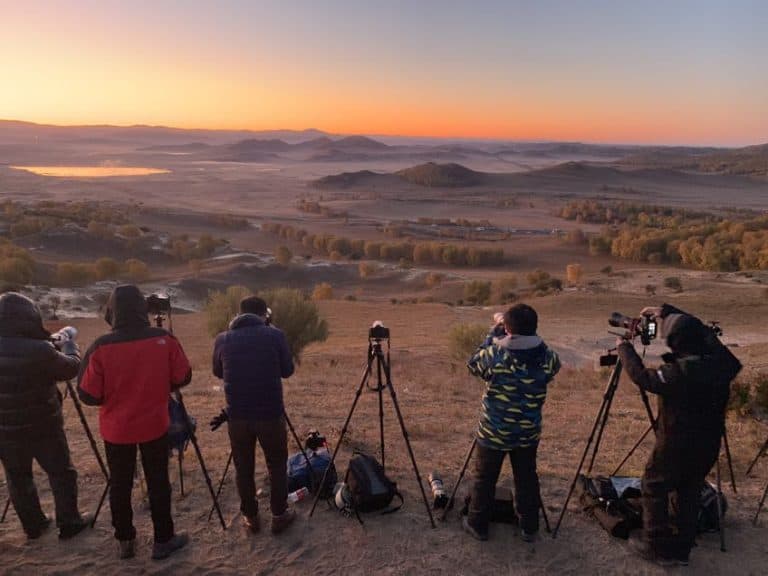Symmetry in Photography – Creating Photographic Harmony
In the world of photography, there exists a captivating concept that effortlessly draws the human eye into a realm of harmonious balance – symmetry. Symmetry in photography is not merely a technical term; it is an artistic language that speaks volumes through the subtle alignment of elements. At its core, symmetry in photography refers to the art of capturing mirror-like reflections, where one side mirrors the other in flawless equilibrium. The allure of symmetrical photos lies in their ability to evoke a sense of order, drawing viewers into a visual dance that explores the intriguing question: what is symmetry in photography? Guided by the rule of symmetry, photographers orchestrate their compositions, giving rise to images that resonate with a profound sense of aesthetic resonance that invite us to explore the captivating beauty of perfectly balanced frames.
Table of Contents
Types of Symmetry in Photography
Throughout photography, where visual poetry is penned with light and imagination, the concept of symmetry emerges as a captivating storyteller. As the lens captures the world in all its glory, the artful arrangement of elements in symmetrical compositions creates a dance of equilibrium that beckons our eyes. But what exactly is symmetry in photography? It is the enchanting harmony achieved when a photograph’s elements mirror each other in a way that resonates with innate aesthetic sensibilities.

Vertical Symmetry
Imagine standing before a tranquil lake, its glassy surface reflecting a serene landscape back upon itself. This is the magic of vertical symmetry in photography. By dividing the frame vertically and arranging elements on one side to echo those on the other, a perfect equilibrium is born.
An architectural marvel or a towering tree can find its poetic partner in the shimmering water below, creating a visual dialogue that stirs both the imagination and contemplation.
Horizontal Symmetry
The grandeur of a towering mountain finds its artistic match in the placid embrace of a calm lake. This is the enchantment of horizontal symmetry. By dividing the frame horizontally, the elements above and below become mirror images, invoking a sense of serenity and balance. Such compositions often breathe life into landscapes, transforming them into breathtaking reflections of nature’s majesty.

Radial Symmetry
Step into the heart of a rose in full bloom, and you step into a world of radial symmetry. Here, elements radiate from a central point, much like the petals of a flower. This form of symmetry in photography draws the eye into a mesmerizing whirlpool of patterns, creating a sense of depth and intrigue.
Mandalas, wheels, and spirals are brought to life through this captivating arrangement, where every glance unveils a new layer of intricate beauty.
Bilateral Symmetry
The flutter of a butterfly’s wings finds its echo in the stillness of a mirrored pond through bilateral symmetry. This style of symmetry is a game of perfect halves, where the frame is divided into two mirror-like sections. Elements on one side find their counterpart on the other, creating a mesmerizing duet of visual poetry. From majestic architecture to delicate subjects, bilateral symmetry infuses images with an air of elegance and precision.
In the heart of these symmetrical photos lies a guiding principle – the rule of symmetry.
This rule, though not etched in stone, serves as a beacon for photographers seeking to wield the power of symmetry in their compositions. It encourages the deliberate arrangement of elements, allowing them to harmonize and create a captivating visual journey. The rule, however, is not a strict jailer, but a trusted ally, as breaking from symmetry can also yield compelling results, introducing dynamism and tension into an otherwise harmonious world.

In conclusion, the tapestry of symmetry in photography is woven with threads of vertical, horizontal, radial, and bilateral intricacies. Each type of symmetry paints a distinct picture, inviting viewers to traverse the delicate balance between familiarity and surprise. As photographers harness the magic of symmetry, they craft not just images but immersive experiences – snapshots of a world where order and beauty dance in perfect unity.
The Art of Finding Symmetry
You will find that within photography a pursuit transforms the ordinary into the extraordinary through the art of finding symmetry. Symmetry in photography is not merely a technique; it is a dialogue between the creative mind and the world’s hidden harmonies.
But what precisely is this art of symmetry, and how does one uncover its captivating secrets?
Identifying Natural and Man-Made Symmetry
Nature, in its boundless creativity, often lays out symmetrical wonders at our feet. The wings of a butterfly, outstretched in delicate precision, mirror one another in a delicate dance of equilibrium. Similarly, a seashell’s spiral whispers of a mathematical poetry that captivates the eye. Recognizing these naturally occurring symmetries, photographers capture moments that celebrate the universe’s elegant geometry. On the other hand, human ingenuity weaves its own symmetrical tales. Urban architecture provides a playground for capturing man-made symmetries – the repeating windows of a skyscraper or the orderly arrangement of columns in a grand hall.

Using Reflections for Symmetrical Compositions
Mirrors in nature – tranquil lakes, rippling ponds, and still puddles – are the artist’s ally when crafting symmetrical compositions. Imagine a lone tree stretching its branches toward the sky, only to find its twin reflected in a calm body of water below. The result is an enchanting reflection, a dialogue between reality and its mirrored counterpart.
This artful play of light and reflection adds depth and intrigue to the image, inviting viewers to question which world is real and which is a magical mirage.
Utilizing Architecture and Urban Elements for Symmetry
The concrete jungles that punctuate our landscapes are a treasure trove of symmetrical possibilities. Architectural marvels, with their clean lines and meticulous geometry, offer photographers a playground of order and rhythm. Imagine a bridge arcing gracefully over a river, its reflections forming a perfect circle, a testament to human engineering and nature’s response. Urban environments, too, gift photographers with symmetrical stories. Rows of streetlights casting their glow along a cobblestone path, or the interplay of shadows and light on a city square – these moments of urban symmetry capture the pulse of civilization in harmonious stillness.

In the end, the art of finding symmetry is about more than technical precision; it is about the dance between order and creativity. It is an invitation to explore the world’s hidden patterns, both natural and man-made, and to reimagine them through the lens of artistic vision. As photographers embark on this quest, they illuminate the world’s symmetrical secrets, capturing moments that speak to the innate human yearning for balance, beauty, and the tantalizingly familiar.
Creating Balance Through Symmetry
Symmetrical photos hold within them a power that extends beyond the mere arrangement of elements; they are vessels of balance that resonate with the human spirit. But how does symmetry create balance, and what secrets lie within its depths?
Achieving Visual Harmony With Symmetry
Symmetry in photography is not simply about mirroring elements; it is about crafting a scene that whispers of order and tranquility. Imagine a lone sailboat adrift on a mirrored lake, where sky and water seem to emerge into one seamless expanse. This visual harmony, nurtured by the rule of symmetry, beckons viewers to lose themselves in a serene moment of perfect balance. The symmetrical composition guides the eye with a gentle hand, allowing us to explore every corner without feeling lost in chaos.

Balancing Asymmetrical Elements With Symmetry
The magic of symmetry does not stop at perfect mirroring. It possesses the alchemical ability to balance the asymmetrical, to weave order into the tapestry of randomness. Imagine a solitary figure standing off-center in a grand hall, while the arches and pillars radiate symmetrical splendor around them. The asymmetrical figure finds its anchor in the symmetrical surroundings, creating a yin-yang of visual balance.
Here, symmetry acts as a stabilizing force, inviting asymmetry to dance in a space where balance reigns supreme.
Contrast Between Symmetry and Chaos
The art of finding balance through symmetry gains its intrigue by being juxtaposed with the chaotic. Imagine a bustling marketplace, its vibrant chaos frozen in a photograph where every merchant stall lines up in perfect symmetry. The contrast between the ordered and the chaotic creates a dynamic tension that holds the viewer’s gaze. It is a reminder that amidst the unpredictability of life, we find solace in the balanced and the familiar.
Between the dance of symmetry and chaos, photographers find a canvas where they wield the brush of artistic expression.
The rule of symmetry, a guiding light, helps them navigate this dance, leading to moments of perfect balance. Yet, photographers are not slaves to this rule; they are its masterful interpreters. As they create symmetrical compositions, they understand that breaking from the mold can yield equally captivating results. An unexpected burst of color, a hint of asymmetry, or a solitary figure against a symmetrical backdrop – these are the strokes that infuse their creations with life and energy.

The art of creating balance through symmetry in photography is a tale of order and chaos, woven together with a masterful hand. Symmetrical photos tell stories that resonate deeply with our innate sense of harmony, drawing us into scenes where the world finds stability. They invite us to explore and appreciate the beauty of balance, reminding us that within this delicate dance, lies a reflection of the human quest for meaning and serenity in an ever-shifting world.
Techniques for Capturing Symmetry
Symmetrical photos, like mesmerizing reflections, hold the power to pull us into a world of perfect balance. But how can photographers master the techniques to capture this captivating balance? Let us dive into the art of crafting symmetrical compositions.
Framing and Centering Your Subject
At the heart of capturing symmetry lies the meticulous art of framing. Imagine an ornate doorway standing tall at the center of your viewfinder, flanked by identical elements on either side. By placing your subject dead center and ensuring that its mirrored counterparts align symmetrically, you create an image that oozes balance. This technique is a masterful embrace of the rule of symmetry, guiding you to compose scenes where every element finds its mirror image partner.

Using Gridlines and Guidelines for Precision
The precision required to craft symmetrical photos can be made effortless with the aid of gridlines and guidelines. Visualize your viewfinder overload with a three-by-three grid, with your subject fitting perfectly within its center square. This grid becomes your map to perfect symmetry.
Guidelines, whether imagined or actual, are your artistic scaffolding, they guide you in placing elements with accuracy, ensuring that your composition maintains a harmonious balance.
Employing Symmetry in Portraits and Landscapes
Symmetry is a versatile language that transcends genres. In portraits, it can frame a subject with graceful precision – imagine a face divided evenly, each expression mirrored to perfection. Landscapes become poetic vistas when captured symmetrically. A lone tree at the center of a pristine meadow, its reflection rippling in a still pond draws us into a world where nature herself composes symphonies of balance.

Manipulating Symmetry in Post-Processing
The beauty of modern photography lies in the power of post-processing to elevate your creations further. The symmetrical world you envisioned while shooting can be refined during the edit. Digital tools allow you to fine-tune alignment, ensuring that every element finds its harmonious counterpart. Enhancing colors, refining textures, and even creatively altering symmetry’s precision are all part of the post-processing journey, giving you the freedom to bend the rules while preserving the essence of symmetry.
Symmetry in photography is more than technical prowess; it is an invitation to explore the interplay between order and imagination.
With each click, photographers unveil moments of perfect stability that speak to human desire for harmony and beauty. So, whether you are capturing the elegance of architecture or the grace of a human form, the techniques for capturing symmetry are your key to unlocking a world where balance reigns supreme.
Symmetry in Different Photography Styles
The expansive canvas of photography reveals that symmetry is able to stand as a universal language, one that transcends genres and styles, weaving its captivating spell across landscapes, architecture, macro worlds, and even the intimate realm of portraits. Each style becomes a stage for symmetry to tell its unique story, enriching the visual narrative with a mesmerizing sense of balance.
Landscape Photography and Horizon Symmetry
Imagine a tranquil sunset over a serene lake, where the sky’s reflection mirrors the world above. In landscape photography, the horizon is the canvas where symmetry paints its most poetic tales. By perfectly aligning the horizon with the middle of the frame, photographers harness the rule of symmetry, crafting images that evoke a soothing balance between the heavens and the earth. This harmonious dance between land and sky invites viewers to lose themselves in the tranquil balance of the scene.

Architectural Photography and Structural Symmetry
The world of architecture becomes a playground for symmetry to flex its creative muscles. From grand cathedrals to modern skyscrapers, the meticulous alignment of elements can transform buildings into architectural poetry. By framing a structure with precision, photographers capture its structural symmetry, allowing viewers to appreciate the rhythmic interplay between columns, arches, and lines.
These symmetrical photos are visual odes to human design and the pursuit of geometric perfection.
Macro Photography and Radial Symmetry in Nature
In the miniature worlds of macro photography, symmetry takes on a mesmerizing form – radial symmetry. Picture the intricate patterns on a seashell or the delicate petals of a flower unfurling in perfect harmony. Here, nature’s mathematical precision is on display, with elements radiating from a central point like a hypnotic mandala. Capturing this radial symmetry requires both the eye of an artist and the precision of a mathematician, resulting in images that reveal the hidden geometries of the natural world.

Portrait Photography and Facial Symmetry
Even in the realms of the human face, symmetry weaves its enchanting spell. The human fascination with facial symmetry spans centuries, as artists and photographers have sought to capture the harmony between left and right. Portraits that embrace facial symmetry draw viewers into the captivating symmetry of the individual, creating a sense of visual harmony that resonates on a deeper level.
These symmetrical photos become intimate windows into the essence of the subject’s character and beauty.
Across these diverse photography styles, symmetry is the unifying thread that sews together compositions with elegance and allure. While adhering to the rule of symmetry provides a sound foundation, photographers understand that bending and even breaking this rule can yield equally captivating results. It is the ability to wield symmetry as a tool while infusing it with a personal touch that defines a photographer’s artistic voice.
Technical Considerations
Wherever you look within and throughout the realm of symmetrical photography, every click of the camera becomes a symphony of technical considerations. The art of capturing symmetrical photos demands not only creative vision but also meticulous attention to the tools and techniques that bring perfect balance to life.

Choosing the Right Camera and Lens
Just as a maestro selects the perfect instrument for a concerto, a photographer must choose the right camera and lens for symmetrical compositions. A camera with a high-resolution sensor can capture intricate details, ensuring that every element aligns with pristine precision.
A wide-angle lens can encapsulate expansive scenes, while a prime lens can offer crispness and clarity, enhancing the beauty of symmetrical details.
Proper Lighting for Symmetrical Shots
Lighting is the brushstroke that illuminates symmetrical scenes with grace. Soft, diffused light is the secret to even illumination, ensuring that every mirrored detail shines with clarity. Shadows, when present, should fall symmetrically, enhancing the balanced aesthetic. Whether natural or artificial, mastering lighting techniques is the gateway to symmetrical photos that embrace the interplay between light and order.

Tripods and Stability for Precise Symmetry
The heartbeat of symmetrical photography lies in unwavering stability. A tripod becomes the photographer’s steady hand, ensuring that every element aligns perfectly. This is especially vital for longer exposures or capturing intricate details. Remote shutters prevent camera shake, allowing for crispness in every mirrored detail.
With the camera held steadfast, the symmetrical scene unfolds with meticulous accuracy.
Post-Processing Tools for Enhancing Symmetry
Beyond the click of the shutter, the realm of post-processing offers another layer of control over symmetrical compositions. Software tools allow photographers to fine-tune alignment, correcting minor discrepancies that may have occurred during shooting. Enhancing symmetry can be a delicate balance – a slight nudge here, a subtle adjustment there – all while preserving the authenticity of the scene. Post-processing is where the artist’s vision and technical finesse converge to create symmetrical photos that resonate.

In the symmetrical world, where form meets precision, photographers are the architects of visual equilibrium. The technical considerations, from choosing the right gear to mastering lighting, stability, and post-processing, are the tools that turn imagination into tangible art. With each click, photographers orchestrate a symphony of balance and order that resonates with the innate human desire for harmony and beauty. Whether capturing the grandeur of architecture or the delicate details of nature, the pursuit of symmetrical perfection is an art form that rewards the marriage of creative vision and technical mastery.
Frequently Asked Questions
What Is Symmetry in Photography?
Symmetry in photography refers to a compositional technique where elements within an image are balanced and mirror each other alongside an axis. It is the art of capturing scenes in a way that creates a sense of balance and harmony, often resulting in images that are visually pleasing and captivating.
Where Can I Find Inspiration for Creating Symmetrical Photos?
Inspiration for symmetrical photography can come from architecture, nature, urban environments, patterns, reflections, and even human faces. Look for repetitive shapes, balanced compositions, and scenes that evoke a sense of order and harmony.
Are All Symmetrical Compositions Perfectly Centered?
While many symmetrical compositions have a centered subject, not all of them need to be perfectly centered. As long as the elements on one side of the axis mirror those on the other side, a symmetrical effect can still be achieved, even with off-center subjects.
Duncan completed his diploma in Film and TV production at CityVarsity in 2018. After graduation, he continued to delve into the world of filmmaking and developed a strong interest in writing. Since completing his studies, he has worked as a freelance videographer, filming a diverse range of content including music videos, fashion shoots, short films, advertisements, and weddings. Along the way, he has received several awards from film festivals, both locally and internationally. Despite his success in filmmaking, Duncan still finds peace and clarity in writing articles during his breaks between filming projects.
Duncan has worked as a content writer and video editor for artincontext.org since 2020. He writes blog posts in the fields of photography and videography and edits videos for our Art in Context YouTube channel. He has extensive knowledge of videography and photography due to his videography/film studies and extensive experience cutting and editing videos, as well as his professional work as a filmmaker.
Learn more about Duncan van der Merwe and the Art in Context Team.
Cite this Article
Duncan, van der Merwe, “Symmetry in Photography – Creating Photographic Harmony.” Art in Context. September 20, 2023. URL: https://artincontext.org/symmetry-in-photography/
van der Merwe, D. (2023, 20 September). Symmetry in Photography – Creating Photographic Harmony. Art in Context. https://artincontext.org/symmetry-in-photography/
van der Merwe, Duncan. “Symmetry in Photography – Creating Photographic Harmony.” Art in Context, September 20, 2023. https://artincontext.org/symmetry-in-photography/.









